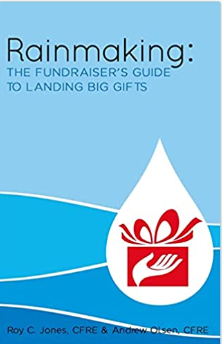This week I had dinner with major donor and board member for one of our charitable fundraising clients. We exchanged pleasantries and shared a few stories from our careers… mostly about how our paths had crossed working for Ronald Reagan in the late 70’s.
Finally, he circled back around to the purpose of our visit…
“When you get to my stage in life you begin thinking about your footprints,” said the gentleman, “It is not about what you keep, but what you can give away… It is not about how much money you make, but what you can do to keep impacting the world after your time is up… you have to leave some footprints.”
This man, who has literally given millions away to charity and political causes over the last six decades, refuses today to retire. As a matter of fact, he has recently launched a whole new product line and is traveling like never before to get it up and running.
I walked away with a deep respect for this man. He had made such an impression on me. When he could have been retired like most of his peers, in the 4th quarter of his life, he has decided instead to “leave a few more footprints”.
This is the reason why the vast majority of donors today are over 60 years of age regardless of whether they give at events, by mail, by internet or telephone. It shouldn’t be surprising that the average age of a planned gift donor is 72… as donors grow older they stop making “gifts” and start making “investments” to their favorite charities and causes. As donors reach their mid-80’s they have liquidated most of their estates to children, grandchildren and charitable causes. The often need secure revenue from their remaining
The most important step an organization can take is to institutionalize the planned giving process so that donors know where to go and what to do when they are ready to start leaving “footprints” as part of their legacy of life. It is so unsettling to me when I see development professionals expressing excitement about receiving an unexpected bequest check or attorney’s letter. The “unexpected” gift is a sign that the organization does not have a fully developed planned giving program.
How about your organization? Are you surprised when a bequest check shows up? If you are it is likely a sign that you do NOT have a formal process for identifying planned gifts or assisting your donors with their estate plans. Here are a few quick tips for getting your program off and running fast:
- Create a Legacy Giving Society. First and foremost you have to create a reason for donors to tell you that they have you named in their will or have a planned giving instrument that will one day help the organization. Planned gifts are revocable in most cases and a donor can easily take a charity out of their will at any time. Encouraging donors to notify you so that you can send them their FREE newsletter and benefit package is important. It doesn’t need to be anything extravagant. Some charities do framed certificates others give a premium like a coffee mug or paperweight. The simple fact is you are creating a “reason” for the donor to tell the charity of their intent and then creating a reason to say thank you every year.
- Talk About the Planned Gift Often. Make sure you are mentioning the planned gift in all of your organizations publications. It should be positioned that every person, staff member or supporter can name the charity in their will. Every direct mail piece, every e-mail and every newsletter should have some mention of planned giving. As importantly, you should be saying that every person needs a will. Allowing your assets to be taken and distributed by the state in probate is truly poor stewardship. Create or purchase a “free will kit” for your donors and supporters and give it away to anyone and everyone.
- Start Asking for the Planned Gift. Planned gifts can come in the form of cash, annuities, securities, real estate, life insurance, trusts and assets from a retirement plan. Chances are that most of your donors have thought about planned giving, but most are never asked for the gift. At least twice each year you should write your multi donors, and especially donors how have written you 100 checks or more, to ask the donor to consider naming you in their will. Offer a FREE will kit and have a list of attorneys and accountants could help draft financial instruments if needed.
- Recognize and Empower Planned Givers. Every issue of your newsletter should have a testimonial with a photo from a person in their 70’s or 80’s telling why than named your charity or ministry in their planned giving estate plan. Create a quarterly luncheon with your planned givers and recognize the new members of the legacy society at every meeting. Give them an “insiders” look at your ministry, and most importantly, keep asking them for donations. In most cases, legacy society members will be your most consistent givers. Remember, you are not looking for people who have written the biggest checks. You are searching for donors who have written the most checks… regardless of amount. Giving frequency is the biggest indicator of who is ready to make a planned gift.
- Create a Planned Giving Toolbox. In addition to a “FREE WILL KIT” your organization should create a Planned Giving Toolbox for your donors. It should model contacts and financial instruments and various types of gifts, which, in turn, can encourage other types of giving. In most cases planned giving donors use the charity to earn higher interests rates from their retirement funds. In exchange, the charity gets to keep the principal or receives the donation when the donor dies. You should develop examples to share with the donor and their financial advisor on how your organization can to handle other types of planned gifts like charitable gift annuities, charitable remainder trusts, charitable lead trusts, and retained life estate.


